Honda CBR1000RR / SP 2017 test: neither gross nor submitted !
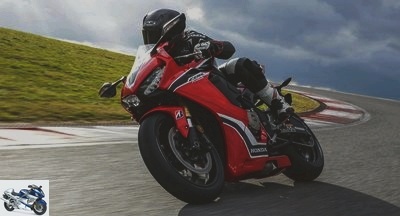
Forget the old CBR1000RR lacking in performance and technology: Honda celebrates 25 years of its Fireblade with a redesign – finally – at the top level. And thanks to its advanced electronics, this 2017 CBR1000RR and its luxurious SP versions are full of sensations without betraying its original concept of "Total Control". Test.
Page 3: Technical point MNC Honda CBR1000RR and CBR1000RR SP
Engine
If the 2017 CBR1000RR engine remains an in-line 4-cylinder like the (reread our), almost everything is new inside, starting with its ultralight casings (magnesium for the ignition, aluminum for the clutch ).
The narrower and lighter radiator (-30 mm and -100 g), the lightened pinion and the titanium silencer (-2.8 kg) participate in this hunt for drastic weight, noticeable in the smallest detail: “the length of the screws , the hoses of the cooling circuit – and their clamps – has been limited ”, even specify the engine manufacturers. !
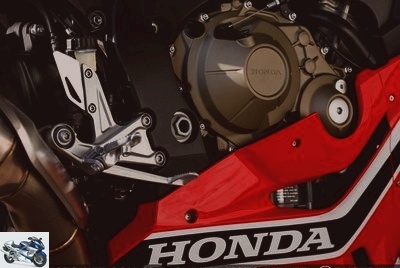
More powerful 12 hp (192 hp against 180 in 2016) and a bit more torque (114 Nm on the standard, 116 Nm on the SP thanks to specific mapping), this 999.8 cc engine adopts for the first time a electronically controlled throttle (throttle by wire). This new device already says a lot about the change of approach: until now, only the MotoGP RCV had it !
The Fireblade took the opportunity to introduce a more efficient and lighter anti-dribble clutch. This goes through aluminum cams instead of steel, to reduce the pressure on the clutch plates during downshifts..
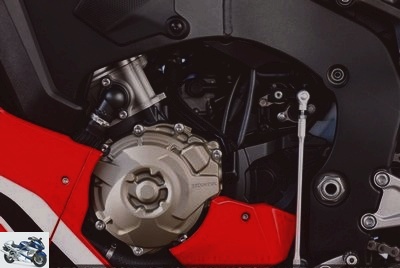
The basic values of bore and stroke are identical to those of the 2016 model (76×55 mm), but the compression ratio increases significantly (from 12.3 to 13: 1) thanks in particular to new high-performance pistons and more aggressive distribution. The piston crown has been redesigned for this purpose. The maximum speed increases at the same time to 13,500 rpm. Fortunately, this radicalization does not translate into a surge in maintenance costs: the service intervals remain fixed “at 12,000 km”, reassures us Bruno Skotnicki, press manager of Honda Moto France.
Cycle part
The quest for the best weight / power ratio obtained in (196 kg for 192 hp as standard, 1 kg less in SP) involves a lot of work carried out on the perimeter aluminum frame, the wall thickness of which decreases to grab 300 g . Shorter than in 2016 to reduce the wheelbase, the Pro-Link unit-type aluminum swingarm (with linkage) is also 100 g less.
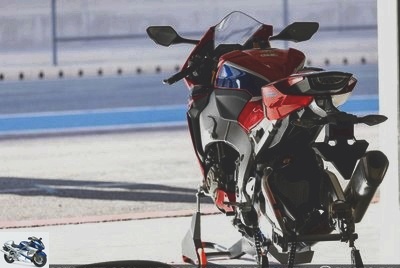
Honda assures that the transverse rigidity of the chassis does not suffer. Better still: torsional flexibility would increase by “10%”, to the benefit of reactivity! Lighter and more manageable at the same time: frankly, what are the people asking for? Perhaps the assurance that this "ultra-light" frame does not bend too easily in the event of a fall … The geometric values do not change: 23.2 ° of caster angle and 96 mm of drag on the standard CBR, or a very closed front end which explains the incredible agility of the Fireblade. The very short wheelbase is 1405mm, on par with the formidable Yamaha R1.
More radical, the SP declination still displays a few millimeters, mainly because of its different suspensions (Showa on the standard, Ohlins on the SP): its caster angle goes down to 23 ° (-0.2 °) and its wheelbase is reduced to 1404 mm. We are close to the minimum limits to ensure irreproachable stability on such a powerful Superbike !
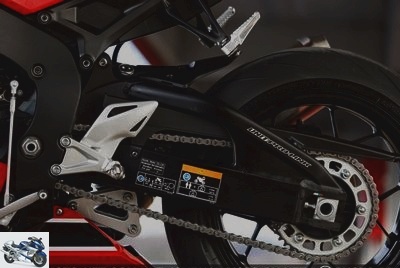
Another part seriously revved up on the two versions of CBR (and even three with the exclusive SP2 version produced at only 500 copies per year): the rear buckle, which would weigh 800g less. MNC weighed it down during the test: it’s frankly bluffing lightness! The aluminum rims are in tune with 100 g less on the scale. They are fitted with 120/70/17 and 190/50/17 tires, common dimensions on current hypersports. The standard receives Bridgestone S21 and the SP of Bridgestone RS10.
On the standard version, damping is based on a Showa “BPF” 43mm inverted fork – which uses large pistons to manage hydraulic pressure more finely – and a gas-fired monoshock from the same manufacturer. Everything is fully adjustable (preload, compression and relaxation). The electronic steering damper HESD (Honda Electronic Steering Damper) is renewed in its excellent functions: remember that this system specific to the winged crest stiffens automatically according to the speed, which allows to have such a smooth steering at low speed that totally unruffled at high speed.
On the braking side, the standard Fireblade features Tokico radial calipers – said to be lighter – one of the characteristics of which is to dispense with the axle for the pads. As a result, another 150 g less! Without reinforced hoses, this braking system is managed by a combined Nissin ABS, capable of modulating the pressure between the front and the rear according to the position of the motorcycle. Goodbye to the E-ABS system developed at great expense by Honda, whose excess weight (+10 kg) and price (+1000 €) were no longer compatible with the requirements of this new CBR.
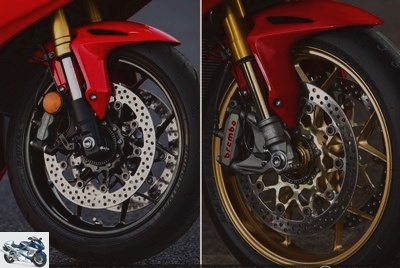
Due to its higher-end status, the CBR1000RR SP receives sumptuous Ohlins suspension (NIX30 front and TTX36 rear) as well as Brembo monobloc brake calipers. Its damping is also managed in real time by electronic means, according to the data collected by the new inertial unit "IMU" (see the electronic part below).
Finally, the “SP” also has a lithium-ion battery and above all a spectacular titanium fuel tank, 1.3 kg lighter than the steel one of the standard CBR1000RR (1.7 kg against 3 kg). We note in passing that the capacity fell by 1.5 liters in 2017, from 17.5 to 16 liters. The trimmed trim of 24 mm on its upper part and 18 mm in the center is also part of this minimalist trend, certainly paying off on the scale but penalizing in practice since autonomy and protection suffer fatidly..

In the end, the CBR1000RR admits 15 kg less on the scale (196 kg base and 195 kg for the SP), which allows it to make the brakes to the yet light Yamaha R1 (199 kg) and the beastly BMW S1000RR (208 kg). The Ducati 1299 Panigale, well helped by its engine architecture (V-twin) and its monocoque frame, however retains its status of “Hypersport hyper-light” with a remarkable weight announced of 190.5 kg with 90% full.
Electronic
This is the area in which the CBR1000RR is making most significant progress in 2017: electronics and piloting aids. The Honda Superbike first receives a fully electronic accelerator, in the form of a potentiometer placed in the throttle – the Acceleration Position Sensor (APS) – which is responsible for converting the rotation executed by the hand into a signal electronic sent to the injection unit.
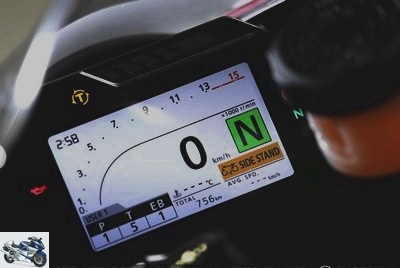
This “throttle by wire” allows you to vary the power distribution thanks to the “Power Selector” function (“P”, bottom left above). Five levels of mechanical responder are thus proposed, the first corresponding to the most energetic. From without filter! This is a first on the Fireblade, so far devoid of "cartos". Riding modes (Riding mode select system) are also set up: Track (circuit), Winding (pleasure) and Street (road). These three modes use pre-set power distribution, traction control, anti-wheeling, and engine brake control settings..
Two “Users” modes are also installed to adjust the values according to your tastes. Switching from one to the other can be done by driving with the gas off, pressing the “MODE” button on the left stalk then scrolling through the possible options using the “SEL” arrows located above (photo above -after). Depending on the driving mode engaged, the engine response but also the action of traction control and engine brake control will be more or less sporty: in Track mode for example, the motorcycle adopts by default a distribution of the most power. lively (1) and traction control intervention is practically at a minimum (level two, out of nine available), just like that of engine brake control (level three out of three).
All these electronic crutches unheard of on a Fireblade are informed by the Bosch MM5 inertial unit, which continuously measures the position of the motorcycle on five axes. Like all other manufacturers, Honda made the choice to source from a reputable equipment supplier, but then developed its own algorithms. In short: the box is "stock", but its internal software is "house".
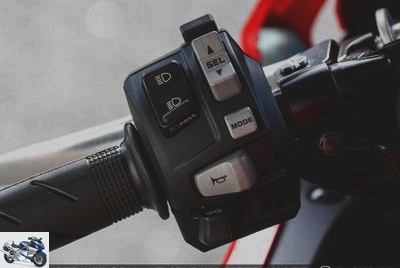
This unit of only 40 g will provide the data necessary to finely control the interventions of the engine brake control, traction control – called “torque control” at Honda – and anti-wheeling: the more the bike is bevelled, the more l he intervention will be gentle and gradual. Same thing concerning its position on a longitudinal plane (attitude) or its roll.
The ABS Nissin also uses this data to adapt its entry into action, fine-tuning its combined action according to the angle taken by the bike. The only downside concerning this braking equipment: unlike the competition, its sensitivity cannot be configured and it cannot be deactivated. The most experienced trackers will have to unplug a fuse to put it on the back burner.
Ohlins Smart EC suspensions (SP versions only)
This IMU (Inertial Measurement Unit) unit also provides information to the control unit on Ohlins electronically controlled suspensions, installed as standard on the SP and SP2 versions. The inclination of the motorcycle, its roll or even its attitude are continuously transferred to the suspension control system “SCU” (Suspension Control Unit), which crosses them with the speed of rotation of the wheels, the engine speed, the pressure applied to the brakes and throttle.
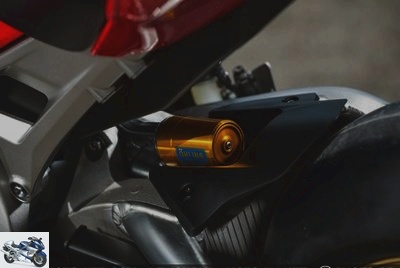
The electronic brain then adjusts the compression and rebound of the suspensions via electro-hydraulic stepping motors. The adjustment of the preload, on the other hand, remains entirely manual, in a "traditional" way, by tightening or loosening the blue anodized nuts at the top of the tubes (photos below). This second generation of suspensions driven by Ohlins (the first being for example used on the R1M) can operate completely autonomously (A) or using manually defined settings (M). All of which offers three preset levels (A1, A2 and A3 or M1, M2 and M3), the last being the most flexible..
In manual, it is possible to fine-tune the action on the hydraulics at the front as well as at the rear, as with "mechanical" suspensions. Except that the screwdriver and the small trigger and preload screws to be turned step by step are replaced by graduations to be selected on the dashboard! To do this, simply press the “Mode” button and the down arrow at the same time when the cursor on the instrument panel is on the suspension function (S).
Where this second generation really stands out is in automatic mode (A): not only are the hydraulic adjustments then managed in real time (between 40 and 80 times per revolution!), But the focusing then becomes significantly more simple. In this configuration, the settings no longer take into account somewhat abstruse measures such as compression and rebound, but just the piloting phase..

In a relevant desire to simplify the settings, Ohlins indeed proposes to fine-tune the behavior of the motorcycle depending on whether it is in the braking phase ("Brake" on the dashboard), when passing through a curve ("Corner") or acceleration ("ACC"). The Swedish Smart EC is able to recognize each of its phases without the aid of a GPS, simply by comparing all the data collected (inclination, engine speed, depression of the springs). A first !
Once the piloting phase has been chosen, the pilot can act on the damping calibration via a scale ranging from +5 to -5. Example: you can harden the suspensions only for braking and loosen them a bit for acceleration. At any time, it is possible to return to the basic parameters ("Default"), in order to start again on a good basis after getting lost in multiple combinations! In the photo below, the suspension function (S) indicates for example "M2", that is to say the second proposed manual mode.
Finally, the CBR SPs receive an “Up and Down” shifter as standard, which operates on upshift and downshift. Changing gear at full load without disengaging or shutting off the throttle becomes all the more obvious as the device offers three degrees of sensitivity to adapt to the “kick” of each individual. The Fireblade also carries the traditional Shiflight (indicator light indicating when to change gear) as well as a speed limiter, always practical to go up the pit lane without exceeding the maximum authorized speed (60 km / h on most circuits).
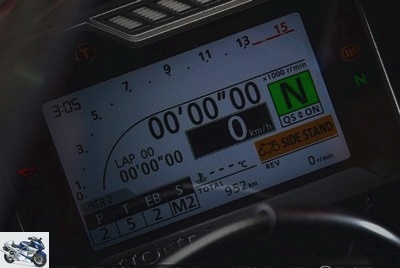
Like most Honda motorcycles, the CBR1000RR receives the "HISS" coded key dear to the winged crest, while its digital instrumentation now uses color TFT matrices. This dashboard is very complete and above all very readable, whatever the light. It includes the engine speed, the gear engaged, the speed, a stopwatch, the odometer, two trips, a clock, the engine temperature and a new indicator of deployment of the side stand (as on the Ducati).
The selected driving mode and the settings for traction control, engine brake and power distribution are also clearly indicated in a window at the bottom left. The scrolling of all this information is done by means of controls placed within reach of a thumb on the left stalk. Only the gasoline level is missing on this real "slab", practically as wide as a medium-sized tablet !
Related articles
-
Honda CBR1000RR / SP 2017 test: neither gross nor submitted ! Forget the old CBR1000RR lacking in performance and technology: Honda celebrates 25 years…
-
Honda CBR1000RR- R SP test: the new 2020 Fireblade sends R ! But what the devil means this fourth R added to the surname of the hypersport Honda…
-
Honda CBR1000RR- R SP test: the new 2020 Fireblade sends R ! But what the devil means this fourth R added to the surname of the hypersport Honda…
-
Honda CBR1000RR / SP 2017 test: neither gross nor submitted ! Forget the old CBR1000RR lacking in performance and technology: Honda celebrates 25 years…
-
2012 Honda CBR1000RR Review: The Twenties Crisis… Unchanged since 2008, the Honda CBR1000RR should have evolved significantly to meet the competition….
-
Sporty – Honda CBR1000RR Fireblade SP 2017: initial information – Used HONDA
2017 Honda CBR1000RR Fireblade SP: first info Expected at the Eicma show in Milan, the new Honda CBR1000RR Fireblade 2017 was unveiled in preview at the…
-
2017 Suzuki V-Strom 1000 XT test: a super cost ! The Suzuki V-Strom 1000 , relaunched in 2013 after a career suspension in 2008 due to Euro 3 standards,…
-
2017 Yamaha YZF-R6 test: no, the Supersport is not dead Yamaha is the only major motorcycle manufacturer to keep its 600 cc sports car in its catalog in…
-
Yamaha R1 and R1M 2020 test: hell of a blow … and salty extra cost ! Yamaha is taking advantage of the changeover to the Euro5 standard to perfect its…
-
Ninja H2 SX test: sporty road bike, in green and against everything ! Kawasaki has no shortage of air: three years after the launch of its Ninja H2 / R,…